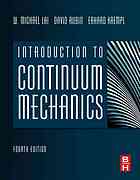Introduction to Continuum Mechanics 2009
دانلود کتاب پزشکی مقدمه ای بر مکانیک پیوسته
| نویسنده |
David Rubin, Erhard Krempl, W Michael Lai |
|---|
| تعداد صفحهها |
536 |
|---|---|
| نوع فایل |
|
| حجم |
11 Mb |
| سال انتشار |
2009 |
89,000 تومان
مکانیک پیوستگی شاخه ای از مکانیک فیزیکی است که رفتار مکانیکی ماکروسکوپی جامدات یا مایعاتی را که به طور پیوسته توزیع می شوند، توصیف می کند. این در زمینه های عمران، مکانیک، شیمی و مهندسی زیستی اساسی است. این متن آزمایش شده برای بیش از 35 سال است که برای آشنا کردن دانشجویان کارشناسی و کارشناسی ارشد مهندسی، و همچنین دانشجویان کارشناسی ارشد، با اصول اولیه مکانیک پیوسته و کاربردهای آن در مسائل مهندسی واقعی استفاده شده است. متن با ارائه دقیق یک کمیت مختصات ثابت، تانسور، که به صورت تبدیل خطی ارائه میشود، آغاز میشود. سپس فرمول بندی سینماتیک تغییر شکل، اعم از بزرگ و بسیار کوچک، و تشریح تنش ها و قوانین اساسی مکانیک پیوستگی را دنبال می کند. به عنوان کاربرد این قوانین، رفتار برخی از مدل های ایده آل مواد از جمله مواد الاستیک، ویسکوالاستیک و ویسکوالاستیک ارائه شده است.
این نسخه جدید پوشش گستردهای از موضوع را هم از نظر جزئیات و هم از نظر محتوا ارائه میدهد و انعطافپذیری بیشتری را برای یک دوره یک یا دو ترم در مکانیک پیوسته یا کشش ارائه میدهد. اگرچه این نسخه فعلی پوشش موضوعی را گسترش داده است، اما از همان رویکرد نسخه های قبلی استفاده می کند – می توان موضوعات پیشرفته را به شیوه ای ابتدایی که از ساده به پیچیده حرکت می کند، با استفاده از انبوهی از مثال ها و مسائل گویا پوشش داد. این یکی از در دسترس ترین کتاب های درسی در مورد این موضوع مهندسی چالش برانگیز است و خواهد ماند.
- پوشش قابل توجهی از الاستیسیته در فصل 5 گسترش یافته است، از جمله راه حل های برخی از مسائل سه بعدی بر اساس رویکرد اصولی به توابع بالقوه
- بخش جدیدی در پایان فصل 4 است. اختصاص داده شده به فرمول انتگرال معادلات فیلد
- هفت ضمیمه جدید در پایان فصل های مرتبط ظاهر می شوند تا به خودکفاتر شدن هر فصل کمک کنند
- مجموعه های مسایل توسعه یافته و بهبود یافته ای که هم فکری را ارائه می دهند. چالش ها و برنامه های مهندسی
Continuum Mechanics is a branch of physical mechanics that describes the macroscopic mechanical behavior of solid or fluid materials considered to be continuously distributed. It is fundamental to the fields of civil, mechanical, chemical and bioengineering. This time-tested text has been used for over 35 years to introduce junior and senior-level undergraduate engineering students, as well as graduate students, to the basic principles of continuum mechanics and their applications to real engineering problems. The text begins with a detailed presentation of the coordinate invariant quantity, the tensor, introduced as a linear transformation. This is then followed by the formulation of the kinematics of deformation, large as well as very small, the description of stresses and the basic laws of continuum mechanics. As applications of these laws, the behaviors of certain material idealizations (models) including the elastic, viscous and viscoelastic materials, are presented.
This new edition offers expanded coverage of the subject matter both in terms of details and contents, providing greater flexibility for either a one or two-semester course in either continuum mechanics or elasticity. Although this current edition has expanded the coverage of the subject matter, it nevertheless uses the same approach as that in the earlier editions - that one can cover advanced topics in an elementary way that go from simple to complex, using a wealth of illustrative examples and problems. It is, and will remain, one of the most accessible textbooks on this challenging engineering subject.
- Significantly expanded coverage of elasticity in Chapter 5, including solutions of some 3-D problems based on the fundamental potential functions approach
- New section at the end of Chapter 4 devoted to the integral formulation of the field equations
- Seven new appendices appear at the end of the relevant chapters to help make each chapter more self-contained
- Expanded and improved problem sets providing both intellectual challenges and engineering applications




